(i) GDP
In 2005, the GDP of Xinjiang reached RMB 260.4 billion yuan, 19% of which was produced by the primary industry, 44.7% by the secondary industry and 36.3% by the tertiary industry. The per capita GDP was RMB 13,108 yuan, equal to 1600 USD if calculated at the exchange rate in 2005.
GDP of Xinjiang 2000-2005
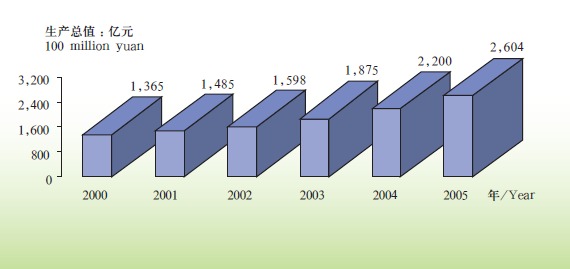
Ratios of Primary, Secondary and Tertiary Industries in Xinjiang 2005
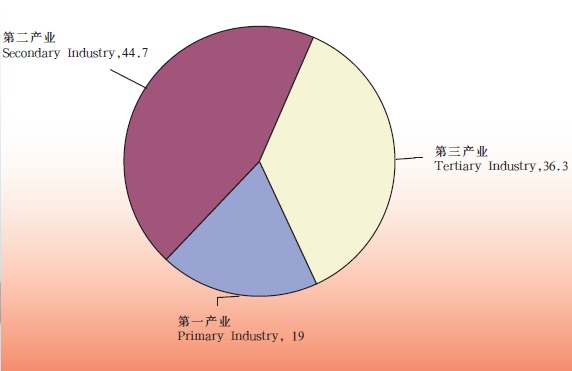
(ii)Resources, Industry and Agriculture
Natural Resources
Xinjiang has 4.063 million hectares of cultivated land, 0.2 hectares per person, which is 2.1 times that of the country. With 51.16 million hectares of pastures and grassland, Xinjiang is one of five major pastoral regions in China. There are 6.77 million hectares of forestland. The volume of water resources accounts for 3% of the total of China. The annual run off of surface water is 85.5 billion cubic meters, with the per capita surface water reaching 4,255 cubic meters, which is 2.24 times that of the average level of the country. 25.1 billion cubic meters of exploitable water exists underground. The reserve of glaciers makes up 50% of the total of China.
Xinjiang boasts complete categories of minerals with large reserves. We can see a bright prospect for exploitation of minerals here. Rich are such minerals as oil, natural gas, coal, gold, chrome, cooper, nickel, rare metals, salts and non-metal building materials. By the end of 2005, 138 large and medium-sized mineral deposits had been found, accounting for 81.6% of the total number of minerals found in China. Of these mineral deposits in Xinjiang, 6 ones are energy mineral deposits, 27 ones are metal mineral deposits, 46 ones are nonmetal deposits and 2 ones are water and gas minerals. In terms of reserve, 9 minerals rank the top in China and 32 minerals take the first place in northwestern China. The reserve of oil stands at 20.86 billion tons, accounting for 30% of the oil reserve in land of China. Natural gas is 10.3 trillion cubic meters in reserve, 34% of the gas reserve in land of the country. There is an estimated coal reserve of 2.19 trillion tons, making up 40% of the national total.
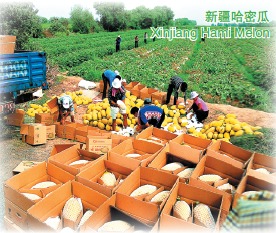
Xinjiang is rich in varieties of biological resources and many of them are unique to Xinjiang. So there is a great potential for exploitation of the biological resources. There are more than 4,000 varieties of wild animals and plants, and more than 10,000 varieties of local crops and introduced crops. In addition, Xinjiang is the origin center and secondary center of many fruit trees, and is abundant in varieties of fruit trees, with the number of fine varieties exceeding 300. Natural medicines are widely distributed, such as ephedra, kendir, liquorice and snow lotus, and they are fine in quality.
Industry
A modern industrial system with complete sectors has been built by and large in Xinjiang, with the mineral exploitation and processing of agricultural products as the mainstay, including exploitation of oil and gas, petrochemical, coal, electric power, textile, building materials, chemical industry, pharmacy and food processing. In 2005, the industrial added value was 96.2 billion yuan, and output of crude oil reached 24.08 million tons, ranking the third place in China. The yield of natural gas came to 10.7 billion cubic meters, taking the second place in the country. 38.99 million tons of raw coal was exploited. The installed generating capacity in 2005 climbed to 6.54 million kw. And 30.7 billion kwh of electricity was generated. In the mix of energy consumption, coal, oil, gas, water power and wind power account for 56.1%, 26.2%, 13.7% and 4% respectively.
Output of Major Industrial Products
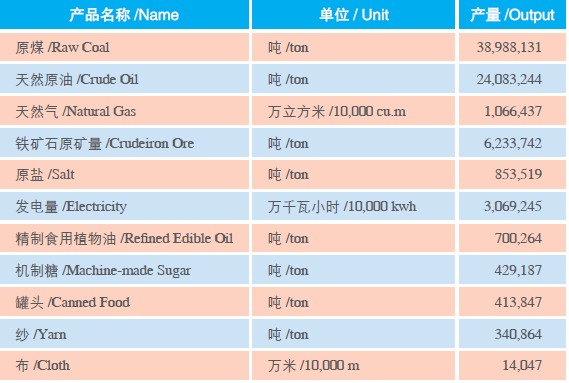
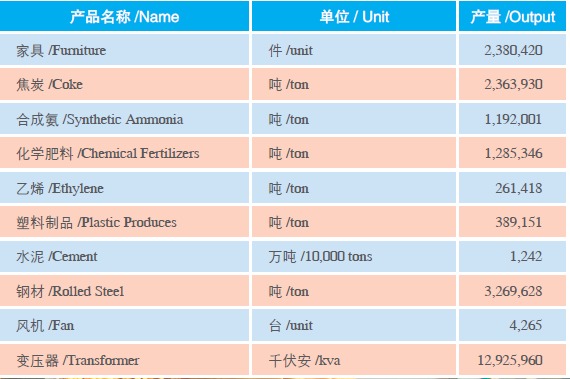
Listed Companies
By the end of 2005, 27 Xinjiang companies had been listed on stock exchanges, with total market value of 40.32 billion yuan, total capital stock of 8.52 billion shares. Totally, 10.74 billion yuan of fund had been raised. Major listed companies include Tebian Electrical, Tunhe Investment, Markor International, Zhonghe, Bayi Steel, Tianli Hi- & New-Tech.
Service Sector
Since the policy of reform and opening up was adopted by China in 1978, the service sector of Xinjiang has grown rapidly, becoming the industry that created the most jobs for people newly entering the workforce. In 2005, 79.16 million people found their own jobs, of whom 51.5%, 15.5% and 33% respectively work in the primary sector, the secondary industry and
the tertiary industry.
Preponderant Industries
As the biggest pillar industry of Xinjiang, petroleum industry produced about 60% of the regional industrial added value. Four major oil fields have been built: Xinjiang Oilfield, Tarim Oilfield, Tuha Oilfi eld and Tahe Oilfi eld. A number of petrochemical bases with their own characteristics have been built in Karamay, Dushanzi, Urumqi, Korla, Kuqa and Zepu. A system of petrochemical industries has been shaped by and large, being able to refine oil and produce chemical fertilizer, plastics and chemical fiber. Our 200-odd varieties of petrochemical products are sold well both at home and abroad. The year 2005 saw the output of ethane reaching 261,000 tons, sodium hydroxide 300,000 tons, soda ash 126,000 tons, car-bamide 1.177 million tons, sulfuric acid 127,000 tons, resin 788,000 tons, plastics 389,000 tons and 962,000 cover tires. Xinjiang has become an important oil and petrochemical base in western China and a strategic alternative reserve of energy for China in the 21st century.
Coal Industry
Coal industry is a sector with great potential for development in Xinjiang. Three coal bases have been built respectively in Urumqi, Sandaolin of Hami and Aiver Valley. A number of small-sized coal mines have been constructed in Dahuangshan of Changji, East Jungar, Kangsu of Kizilsu Kirgiz Autonomous Prefecture, Tielik of Baicheng County, Ehuoburak of Kuqa County and Tiechanggou of Tacheng. In 2005, the output of raw coal reached 38.99 million tons. Smooth progress has been made in the preparatory work for the connection of Xinjiang Power Grid and Northwest Power Grid. All these have laid a foundation for West-East Electricity Diversion Project and for giving full play to rich coal resource in Xinjiang by building coal power base and coal-chemical industry base.
Agriculture, Forestry, Livestock Husbandry and Fishery
There are abundant resource of sunlight, heat, water and soil in Xinjiang. The local climate features long sunshine hour, high accumulated air temperature and long frost-free period, conducive to the growth of crops. Cotton, grain, beet, fruit, horticulture and livestock husbandry are the leading industries. In 2005, the total output of agriculture, forestry, livestock husbandry and fishery came to 83.11 billion yuan. In this fi gure, the agricultural added value was 49.4 billion yuan, the total yield of grain was 8.772 million tons, and cotton 1.957 million tons. Some agricultural products with local characteristics enjoy high reputation both at home and abroad, and they are cotton, hops, tomato, safflower, medlar, Hami Melon, Turpan grapes, Korla pears and Hotan pomegranates. Presently, the cotton output of Xinjiang makes up more than one third of China's total and 8% of the world's total. The yield of hops accounts for 70% of the national total. The outputs of medlar and safflower account for 50% and 60% respectively of the country's total. Xinjiang has grown into China's largest base of cotton, hops and tomatoes, and an important base of livestock husbandry and beet sugar.
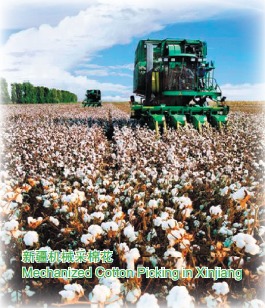
Modern livestock husbandry develops quickly. At the end of 2005, the number of cattle stood at 53.34 million, the output of meat reached 1.415 million tons and the yield of aquatic product came to 79,000 tons.
In 2005, 1.078 million tons of chemical fertilizer was applied in farmland. 3.65 billion kwh of electricity was consumed in rural areas.
Outputs of Main Agricultural Products, Xinjiang (2005)
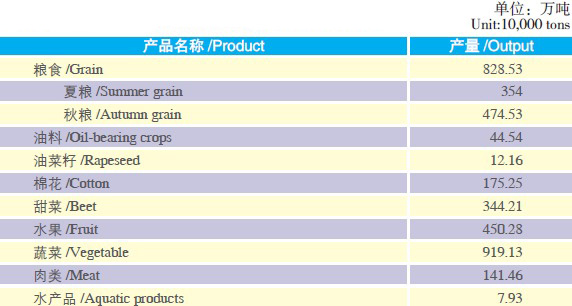
Agriculture with Local Characteristics
Agriculture with local characteristics consist of 10-odd trades such as winemaking, canned food, drinking, milk products, daily chemicals, flavoring essence, spice, processing of gemstone and jade, sugar-making, food, articles used by ethnic minorities. Mass production is conducted for such products as tomato products, grape wine, cotton textiles, fruit juice drinking, safflower products, meddler products, carrot products, cosmetics, flavoring essence, spicery, hops, beet sugar, oligosaccharide, gemstone, jade and articles of ethnic minorities. Good momentum is kept in the development and production of milk wine, fermented mares milk, kendir tea, grape seed oil, pear pectin, food and drinking with Uygur medicinal materials as raw materials.
Xinjiang is one of the world's regions most suitable for the growth of tomatoes. Tomatoes produced here have high content of haematochrome and are fine materials for making tomato products. So far, 137 production lines have been built for tomato products, producing more than 500,000 tons of tomato products a year. The output of tomato products by Xinjiang is in the third place in the world, ranking after the US and Italy. The tomato product yield of Xinjiang makes up more than 90% of China's total and 21% of the world's total, transforming Xinjiang into the largest tomato base in China.
(iii)Business Data
Foreign Trade
The 2005 combined volume of imports and exports was 7.94 billion USD. In this figure, exports make up 5.04 billion USD and imports 2.9 billion USD. In 2005, Xinjiang ranked the fourteenth place in China in combined volume of import and export. Of the GDP of Xinjiang, 24.3% originates from foreign trade. Xinjiang has established economic and trade ties with 147 countries and regions. The trade volume of Xinjiang with central Asian nations and Russia reached 5.87 billion USD, accounting for 74% of its total foreign trade volume.
Business Operation in Xinjiang (2005)
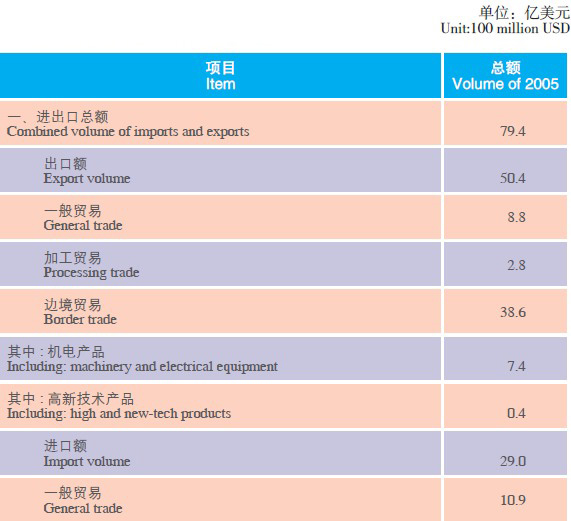
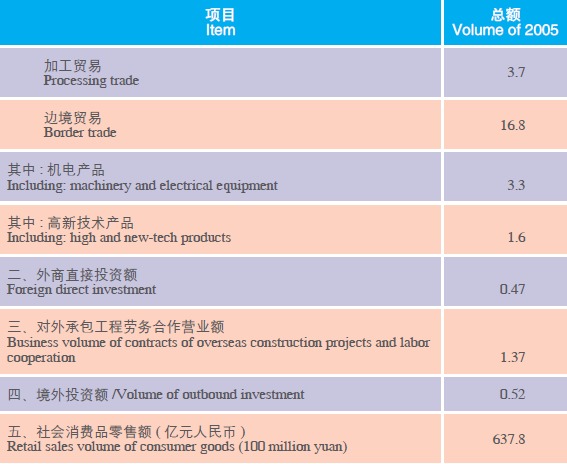
Trade Partners of Xinjiang 2005
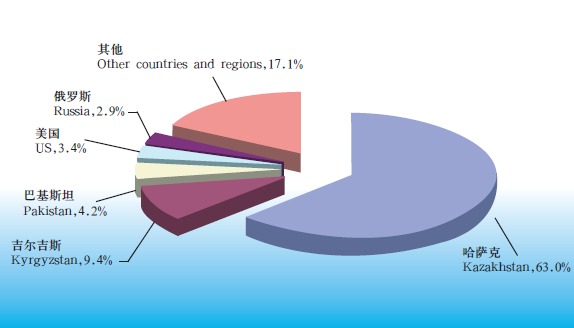
Combined Volume of Import and Export of Xinjiang 1978-2005
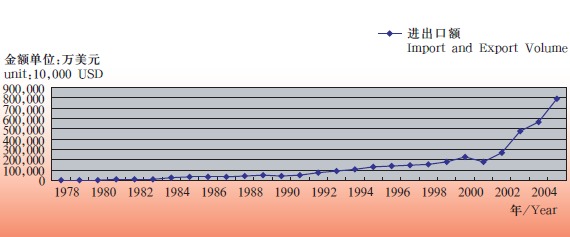
Shares of Import & Export Volume of Enterprises with Different Proprietorship, Xinjiang 2005
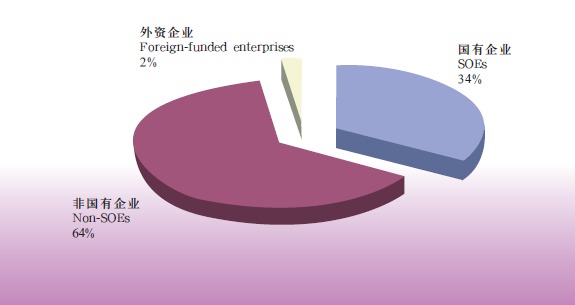
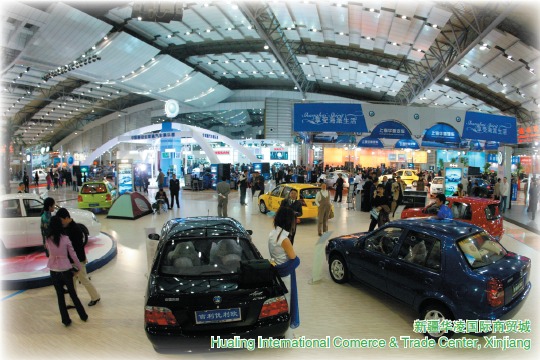
Utilization of Foreign Investment
By 2005, 1,439 foreign investment projects had been approved by the government of Xinjiang, with total contract amounts reaching 2.02 billion USD, and actually 580 million USD of foreign capital had been utilized.
Sources of Foreign Investment in Xinjiang 2005
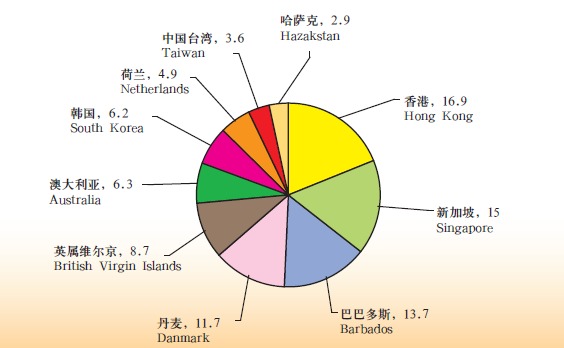
Foreign Economic and Technological Cooperation
In 2005, the business volume of contracts for overseas construction projects and labor service cooperation rose to 137.35 million USD, and 744 laborers worked abroad at the end of 2005. Xinjiang received 20 million USD of international free aid.
Outbound Investment
In the past, outbound investment made by Xinjiang investors mainly took the form of running trade companies. Now the form of outbound investment has gradually transformed into processing materials, technology export, resource exploitation and establishment of sales network. Some Xinjiang enterprises make out bound investment by participating in exploration and exploitation of oil and mineral resources in surrounding countries, production of electronics, agricultural products and food, and forestry operation. By the end of 2005, the outbound investment of Xinjiang had amounted to 52.58 million USD.
Technology Import
In 2005, the local government of Xinjiang approved 19 contracts for technology import totaling 49.11 million USD. Of the total amount of these contracts, 18.98 million USD were spent on technology introduction, covering agriculture, livestock husbandry, manufacturing, aviation, IT, education, scientific research, petrochemical industry and greatly increasing strength of the sectors of petrochemical, oil exploration, iron and steel and civil aviation.
Commodity Circulation
In 2005, the retail volume of consumer goods came to RMB 63.78 billion yuan, of which 50.98 billion yuan was business volume of wholesale and retail sector and 9.05 billion yuan was business volume of catering industry. The retail sales of consumer goods in urban areas reached 44.24 billion yuan and that in rural areas was 19.54 billion yuan.
Ports
In 2005, 12.83 million tons of goods passed through ports in Xinjiang, of which 11.20 million tons were transported through the Port of Ala Tav Pass Port (Alashankou Port).
Opened Ports of Xinjiang
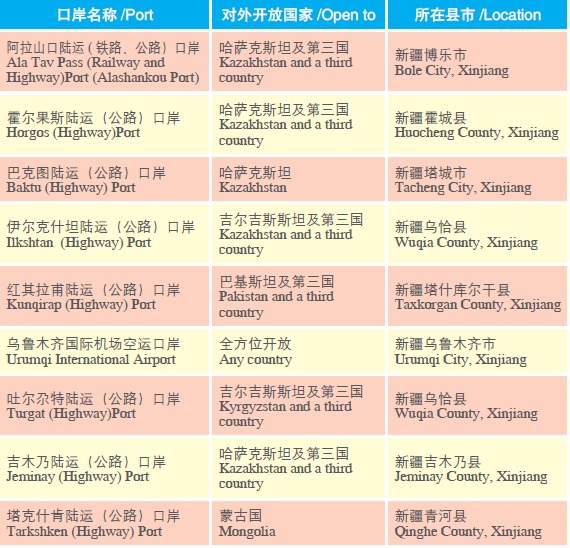

Sino-Kazakhstan Horgos International Border Cooperation Center
In July, the two governments of China and Kazakhstan signed an official agreement to launch the construction of Sino-Kazakhstan Horgos International Border Cooperation Center. Chinese government decided to allocate a land of 3.43 square kilometers on the Chinese side for the Cooperation Center and the part of the Cooperation Center on the Chinese side shall be administrated in accordance with the mode of "inside China, outside the Customs". The Chinese government granted the following special policy to the Center. Inside the Cooperation Center, goods from China for infrastructure development and equipment for Xinjiang use shall be deemed exports, and tax shall be refunded; and goods from Kazakhstan for infrastructure development and equipment for Xinjiang use shall be exempted from tariff and import linkage value-added tax.
Every person entering China through the Cooperation Center shall be exempted from tax for goods brought with him or her as much as RMB 8000 yuan every entry a day. Chinese government also decided to allocate a 9.73 sq.-km land in the Chinese side near the Cooperation Center as the supporting zone, and this part of land shall be used for development of industries oriented towards the Cooperation Center, and the following preferential taxation policy is granted for it: goods entering the zone from abroad shall be bonded; goods entering China from the zone shall be treated as imports; goods entering the zone from China's regions other than Xinjiang shall be treated as exports and tax shall be refunded for them; goods trade between local enterprises of Xinjiang shall be exempted from value-added tax and consumption tax.
Related Articles:
Doing Business in Xinjiang Uygur Autonomous Region of China: Survey
Doing Business in Xinjiang Uygur Autonomous Region of China: Investment
Doing Business in Xinjiang Uygur Autonomous Region of China: Development Zones





